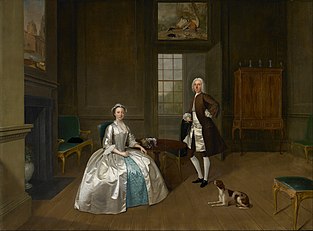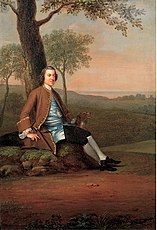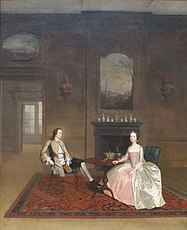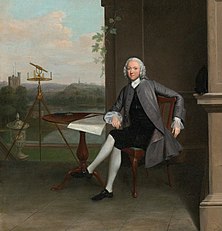art.wikisort.org - Artist
Arthur Devis (19 February 1712 – 25 July 1787[1]) was an English artist, half-brother of the painter Anthony Devis (1729–1816), and father of painters Thomas Anthony Devis (1757–1810) and Arthur William Devis (1762–1822). His place in the pages of art history is generally as a painter of the type of portrait now called a conversation piece.


Arthur was taught by the Flemish painter Peter Tillemans. Though his early work was in part as a landscape artist, he also drew upon family connections to win clientele for portraits of the members of pro-Jacobite Lancashire families. In fact, by 1737 he had gravitated to portrait painting, setting up a studio in London.
In London Devis acquired a considerable reputation, though his success was to follow a certain parabola. Faced with other fashionable artistic currents represented by the work of such painters as Joshua Reynolds and Johann Zoffany, his commissions declined and he was obliged to move to restoring pictures. His marriage in 1742 produced twenty-two children, though few survived. He sold all the paintings in his possession in 1783 and in 1787 died in retirement in Brighton.
Biography
Arthur Devis was born in Preston, Lancashire, the eldest son of Anthony Devis. It may have been the latter, a member of the town council as well as a carpenter and a bookseller, that was responsible for introducing Devis to the Flemish painter Peter Tillemans, who became his teacher.[2] During the early 1730s, Devis is known to have been an assistant in Tillemans's studio, apparently copying views of Italy by artists such as Pannini and Marco Ricci.[3] Not surprisingly, the first work Devis painted on commission, a depiction of a house within its park, also shows his interest in landscape (Hoghton Towers from Duxon Hill, Lancashire, 1735; Private collection). By 1737, however, he had become a portrait painter.[4] In 1745, he established a studio in Great Queen Street, Lincoln's Inn Fields in London, the location of an academy of painting opened in 1711. By this time he had acquired a considerable artistic reputation.
Devis received his greatest number of commissions for portraits between 1748 and 1758.[5] Many of his works have landscape backgrounds, while his interiors, though convincing, are often pure imagination.[6] The exception is the neo-Gothic library at Arbury Hall shown in Devis's portrait of Sir Roger Newdigate, who holds the plan for the room on his knee.[7]
In 1768 he became president of the newly founded Free Society of Artists, where he also exhibited works between 1761 and 1775 and in 1780, but in fact his place in the portrait market was already slumping in the 1760s, and in the face of the output of such as Joshua Reynolds and Johann Zoffany, his work came to be considered outmoded. He was never admitted to membership of the Royal Academy. Art reviewers and observers like Horace Walpole were very critical of it.[8] For income he was obliged to take up restoring pictures, though this could be remunerative. In particular for work executed between 1777 and 1778, he was paid the handsome fee of one thousand pounds for restoring works by James Thornhill (1675-1734) in the "Painted Hall" of the Royal Naval Hospital, Greenwich.[9]
In 1783 Devis sold all the paintings in his possession and in 1787 died in retirement in Brighton. He was buried in the churchyard of St. Mary Paddington, London.[10]
Family
Devis married Elizabeth Faulkner (1719–1788) at St Katharine's by the Tower, London, on 20 July 1742.[11] Of the marriage were born twenty-two children, only six of whom survived past infancy. Two, Thomas Anthony Devis (1757–1810) and Arthur William Devis (1762–1822), became painters. One daughter, Ellin Devis (1746-1820), was a schoolmistress and author of the popular grammar The Accidence (1775). Devis's half-brother Anthony Devis (1729–1816) also was a painter, as was a son-in-law, Robert Marris, who as a young man had lived and travelled with Anthony Devis, and later married Arthur Devis's daughter Frances. The family's artistic interests continued in various ways. For example, the Guernsey physician Martin Tupper (1780-1844) married Robert Marris’s only daughter Ellin Devis Marris, and his eldest son the poet and writer Martin Farquhar Tupper (1810-1889) (d. 1847), married his cousin Isabella Devis, daughter of Arthur William Devis.
Gallery
- Breaking-Up Day at Dr Clayton's School at Salford (c. 1738)
- Thomas Lister and His Family (1740-1741)
- Gentleman with a Cannon (1741)
- The John Bacon Family (1742)
- William Farrington of Shawe Hall, Lancashire (c. 1743)
- Mr and Mrs William Atherton (1744)
- Robert Vernon Atherton Gwillym of Atherton Hall and His Family (1745-1747)
- An Unknown Man with His Daughter (1746-1748)
- Leak Okeover, Rev. John Allen and Captain Chester at Okeover Hall, Staffordshire (1747)
- Mr Peter Ducane (1747)
- The Children of Mr & Mrs Peter Ducane (1747)
- Mr. and Mrs. Richard Bull (1747)
- The Love Song (1749)
- Thomas Cave Family (1749)
- A Family of Anglers (perhaps the Swaine Family of Fencroft, Cambridgeshire) (1749)
- Portrait of a Lady in a Landscape – (1750)
- The James Family (1751)
- Sir Joshua Vanneck, 1st Baronet and Family at Roehampton House, Putney (1752)
- The Clavey family in their garden at Hampstead (1754)
- Sir Roger Newdigate in his Gothic Revival Library at Arbury Hall (1756-1758)
- John Shaw, 4th Bt (1728-1799), of Eltham Lodge (1757)
- Arthur Holdsworth Conversing with Thomas Taylor and Captain Stancombe by the River Dart (1757)
- Philip Howard of Corby Castle, Cumberland (1759)
- Sir John van Hatten (c. 1760-1761)
- Lord Robert Manners-Sutton (1722-1762)
- Jonas Hanway
References
- D'Oench, Ellen G. (2008)
- D'Oench 1980, page 7.
- D'Oench 1980, page 8.
- D'Oench 1980, page 9.
- D'Oench 1980, page 18.
- D'Oench 1980, page 20.
- D'Oench 1980, page 23.
- D'Oench 1980, pages 28–9.
- D'Oench 1980, page 32.
- D'Oench 1980, page xi.
- D'Oench 1980, page x.
Sources
- Pavière, Sydney Herbert, The Devis Family of Painters, Lewis, Leigh-on-Sea 1950.
- Belsey, Hugh. "Devis" in Oxford Art Online (updated 04/07/04).
- D'Oench, Ellen G. (1980). "The conversation piece : Arthur Devis & his contemporaries" (Exh. cat.). New Haven: Yale Center for British Art. ISBN 0-930606-28-0.
- D'Oench, Ellen G. (2008). "Dictionary of National Biography entry for Arthur Devis". Oxford University Press. Retrieved 20 June 2013.
- Seguier, Frederick Peter (1870). A critical and commercial dictionary of the works of painters. Longmans, Green, and co. p. 56.
devis.
External links
- 73 artworks by or after Arthur Devis at the Art UK site
- Arthur Devis at Artcycolopaedia
- Arthur Devis at World Wide Art Resources
- Works by Arthur Devis at Tate Britain
- Devis's Mr and Mrs Atherton (c1743), at the Walker Art Gallery
На других языках
- [en] Arthur Devis
[es] Arthur Devis
Arthur Devis (Preston, 19 de febrero de 1712 - Brighton, 25 de julio de 1787) fue un pintor retratista inglés, conocido en particular por sus conversation pieces y otros pequeños retratos semejantes.[fr] Arthur Devis
Arthur Devis (1712-1787) est un peintre britannique, à la fois paysagiste et portraitiste, particulièrement réputé pour un type de composition appelé conversation piece.Другой контент может иметь иную лицензию. Перед использованием материалов сайта WikiSort.org внимательно изучите правила лицензирования конкретных элементов наполнения сайта.
WikiSort.org - проект по пересортировке и дополнению контента Википедии

























